Thursday 24 November 2016
White: K. Nevols (134) - Black: H. Tassell (147)
1. e4 c6
The Caro-Kann Defence. In a previous game (Game 20) I had faced this defence and was well beaten. So I tried to find something to play against it and, being a lazy person, preferably something I could easily remember.
On a Chessbase DVD (which I had bought in a sale!) there was a video by the Dutch International Master, Robert Ris, which suggested playing 2. Ne2 - an interesting idea - and one particular line which led to a fascinating pawn sacrifice. So I thought I would give it a go.
2. Ne2
The principle is that Caro Kann players like to put a bishop on f5. From the g3 square, this can be attacked.
2. .... d5
3. e5 Bf5
Other moves Black could consider are 3. ... c5 (to be answered with 4. d4) and 3.. d4 (where White could have some fun with 4. b4 or the more conservative 4. c3.
4. Ng3 Bg6
5. h4
The play against the bishop continues.
5. ..... h6
If 5. ... h5 then 6. Be2 and the h-pawn is looking uncomfortable.
6. h5 Bh7
To my surprise, I have got to the position of the pawn sacrifice. At our level, we tend to concentrate more on opening principles and ideas rather than specific lines. However, here I had the chance to carry out some preparation.
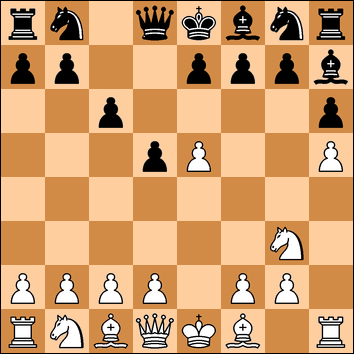
Inwardly I hummed and ha-ed as I pondered whether I should play the safer 7. d4 but then I thought I might not get the chance to play this again - and I never like 'what if?'s - so I thought let's give it a go.
7. e6!?
Here it is. Not many club players get the chance to play a positional pawn sacrifice at move seven. I hoped he had not seen it before and, judging by the way he now went into some thought, I think that was correct.
7. .... fxe6
You can now see the point behind the move. Take a look at the bishop on f8. How it is going to get out? On one side, there are doubled pawns that have to be shifted before it can think of freedom, while on the other, if the g-pawn moves, it will be exchanged for White's h-pawn and his pawn on h6 is poor.
And of course while the bishop on f8 is blocked, the rook on h8 will also struggle to get out.
The other point to note is the opening of the h5-g6-f7-e8 diagonal. White must move fast to exploit this while Black must aim to castle queenside quickly to get the king out of the way.
8. d4
The natural follow up to 7. e6 which restricts the e5 pawn and prepares to bring the king's bishop to d3.
8. .... Qd6
I took a look at 8. .. Nd7 preparing e5. One line could be 9. Bd3 Qa5+ 10. Nc3 e5 and castling very soon or White could play 9. f4 trying to keep the trap closed.
I also wondered about 8. .. e5!? - immediately returning the pawn with 9. dxe5 e6 to follow.
The idea of Qd6, and the next knight move, is to get castling, but Black does not have enough time.
9. Bd3 Bxd3
If 9. .. Na6 I intended 10. Bxh7 Rxh7 11. Qd3 Nf6 12. Qg6+.
10. Qxd3 Na6
11. Qg6+ Kd7
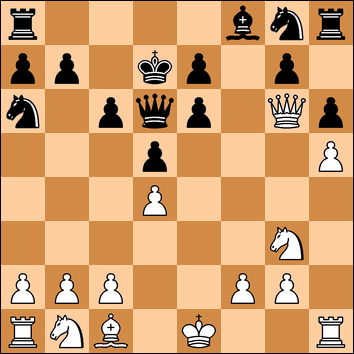
Now the plan was to get a White rook onto the e-file. The longer those pawns stay on e6 and e7, the more development problems Black will have.
12. O-O Nf6
If 12. ... e5 White can retrieve the pawn with 13. Qf5+.
13. Re1 c5
14. dxc5 Nxc5
Black has succeeded in removing the White pawn from d4 and might now be thinking of e5 at some stage, even if it gives the pawn back, but with the intention of e6 and developing the kingside. This would not be possible while White has the option of Nf5 and then taking on g7 instead. White's queen is superbly placed.
I now considered 15. b3 with the idea of bringing the bishop to a3. But after 15. ... Nce4 16. Ba3 the Black queen can simply move to a6 or f4. So I decided to bring the knight into the action while also covering the e4 square which both the Black knights were looking at.
15. Nc3 Rc8
16. Be3
Planning to come to d4 and then e5 - while also peering in the direction of the undefended pawn on a7. Black now can't play 16. .. d4 because of 17. Bxd4 (17. .. Qxd4 18. Red1 wins the queen).
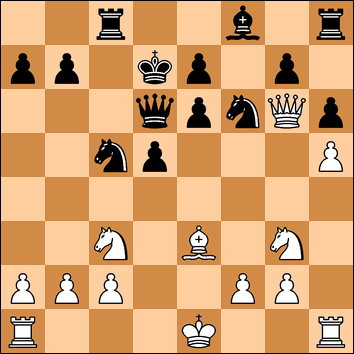
16. .... b6?
A mistake providing White with two free moves to continue the attack. The computer recommends 16. ... Qa6 tucking the queen away. If Black plays 16. .. e5 then White has a good choice of 17. Rad1 which is strong. (17. ... e6 18. Bxc5 Rxc5 19. Nge4) or 17. Nf5 (17. ... Qe6 18. Bxc5 Rxc5 19. Nd4).
Remember Black's bishop on f8 and rook on h8 which I mentioned earlier. Look what a miserable time they are having.
17. Nb5 Qb8
18. Nd4 Qd6
Now if White wanted a draw (for example, to win the match) then he could simply play 19. Nb5 and Black would obligingly repeat moves. But the gain in tempo meant that I had moved my knight from c3 to d4 where it is very happy, looking at b5, e6 and f5.
I gave some thought here to 19. c4 dxc4 20. Rad1 but then Black has the annoying 20. .. Nd3 turning the tables. So instead it is time for the last piece to join the fight.
19. Rad1
The computer now recommends 19. .. e5! and gives the position as equal if, after 20. Ndf5, he can find 20. .... Qb8!
This stops 21. Nxg7 because of Bxg7 22. Qxg7 Rcg8 23. Qf7 Rh7 trapping the queen. White could try the more aggressive 21. c4 with 21. .. Na5 22. cxd5 Nxb2 23. Rb1 Nc4. White could also consider 24. Qf7 but it is hard to see a breakthrough.
19. ..... Nce4
While Black is effectively playing two pieces down, then maybe it is a mistake to exchange.
20. Nxe4 Nxe4
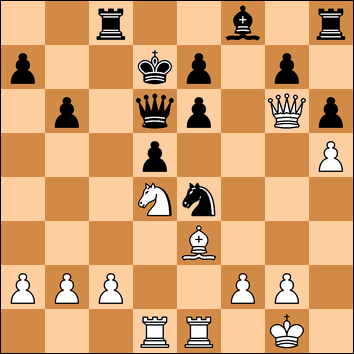
Now a big think. Firstly, I looked at the piece sacrifice 21. Bf4? - 21. ... Qxf4 22. Qxe6+. I could not see anything against 22. .. Kd8 (23. Nc6+ Rxc6 24. Qxc6 Qxf2+) and overlooked the simple 23. Qxd5+ which will win the knight and have a winning attack.
A far better move for Black would be 22. .. Kc7 then 23. Nb5+ Kb8 24. Qd7 Rc5! (defending the d5 pawn). 25. Qxa7+ Kc8 26. Qa6+ (if 26. Qa8+ then Qb8) Kd7 27. Rxd5 Ke8! 28. Qa8+ Kf7.
However, I did not see the need to sacrifice a piece in a winning position where there were other moves available.
I considered 21. f3! which I think is probably the best - clearing the e-file and redeploying the bishop back to f2 and then on to g3.
Instead I went for my third option, to get that bishop to f4 by a more direct route.
21. g3 Nf6
22. Bf4 Qb4
Now having forced the queen off the centre files, how can I finish off the attack against the king? I saw two options - 23. Qf7! was the sensible option - but, rather foolhardily, I decided to gamble.
23. Rxe6
The reason I say this is a gamble is because I thought he might play 23. ... Qxe4!? Then 24. Rxe7+ Bxe7 25. Rxd4, and it is queen and pawn against rook and knight - the type of lop-sided positions I do not like.
23. .... Qxb2?
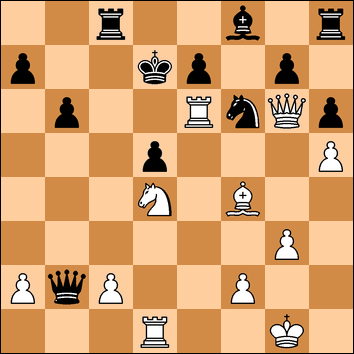
With this move I breathed a sigh of relief. This was my day after all. I saw how I could finish it off from here.
24. Qf5 Kd8
25. Nc6+ Rxc6
26. Rxc6 e6
27. Qxe6 Bc5
The bishop is free at last - just in time for the final whistle.
28. Rc8 mate
I was very pleased with this win, in 28 moves, against a higher graded player by the use of a positional pawn sacrifice. My third win in a row, and nine unbeaten.
Swale v Tunbridge Wells
Keith Hyde (167) 0-1 Robert Jacobs (172)
Trefor Owens (172) 1-0 Russell Goodfellow (160)
Keith Nevols (134) 1-0 Hugh Tassell (147)
Ian Lappin (125) 1/2-1/2 Stephen Bond (119)
Tyrone Jefferies (116) 1/2-1/2 Richard Woodfield (117)
Andrew Gillard (113) 1-0 Peter Orchard (90)
Swale 4-2 Tunbridge Wells
No comments:
Post a Comment